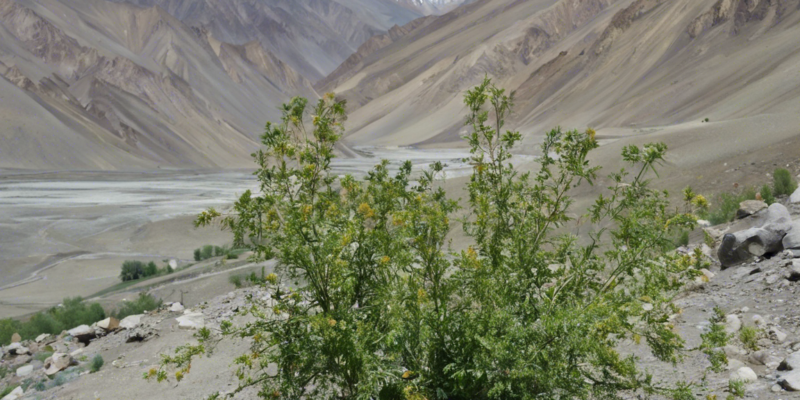Nestled in the northernmost part of India in the state of Jammu and Kashmir, Ladakh is a region known for its stark landscapes, high mountain passes, Buddhist monasteries, and unique vegetation. Due to its high altitude and arid climate, Ladakh is home to a diverse range of plant species that have adapted to survive in this harsh environment. In this article, we will delve into the unique vegetation of Ladakh, exploring the different types of plants that thrive in this high-altitude desert.
Adaptations to Extreme Conditions
The vegetation in Ladakh has evolved special adaptations to survive in the extreme conditions of the region. Some of the key adaptations include:
1. Low Water Needs
- Plants in Ladakh have developed low water needs to survive in the arid conditions of the region. Many plants have succulent leaves or stems that store water to sustain them during dry periods.
2. Cold Resistance
- Ladakh experiences extreme cold temperatures, especially during the winter months. Plants in the region have adapted to withstand these cold temperatures by developing cold resistance mechanisms such as antifreeze proteins.
3. Short Growing Season
- Due to the short growing season in Ladakh, plants have to complete their life cycles quickly. Some plants have adapted by growing rapidly and flowering early in the season to ensure reproduction before the onset of winter.
4. Wind Resistance
- The high-altitude environment of Ladakh is prone to strong winds. Plants in the region have developed wind resistance adaptations such as low, cushion-like growth forms to minimize wind damage.
Types of Vegetation in Ladakh
Ladakh is characterized by different types of vegetation zones based on altitude, ranging from desert vegetation at lower elevations to alpine meadows at higher altitudes. Some of the distinct types of vegetation found in Ladakh include:
1. Desert Vegetation
- The lower valleys of Ladakh are dominated by desert vegetation consisting of shrubs, grasses, and small herbs adapted to arid conditions. Common plant species include saxaul, seabuckthorn, and Ephedra.
2. Alpine Meadows
- At higher elevations, alpine meadows support a diverse range of plant species adapted to cold and harsh conditions. Alpine meadows in Ladakh are characterized by a variety of flowering plants such as Potentilla, Primula, and Gentiana.
3. Dry Steppes
- The middle altitudes of Ladakh are covered by dry steppes dominated by xerophytic shrubs and grasses. Plant species such as Caragana, Stipa, and Artemisia are commonly found in this vegetation zone.
4. High Altitude Desert
- In the higher regions of Ladakh, where the altitude exceeds 5000 meters, the landscape transforms into a high altitude desert with sparse vegetation such as cushion plants, mosses, and lichens adapted to extreme cold and aridity.
Conservation Challenges
Despite its unique and diverse vegetation, Ladakh faces several conservation challenges that threaten its fragile ecosystems. Some of the key challenges include:
-
Climate Change: The impact of climate change is already being felt in Ladakh, with rising temperatures and erratic weather patterns affecting plant species and ecosystems.
-
Overgrazing: Uncontrolled grazing by livestock poses a threat to native plant species in Ladakh, leading to soil erosion and degradation of vegetation.
-
Urbanization: The rapid pace of urbanization and infrastructure development in Ladakh is encroaching upon natural habitats and disrupting fragile ecosystems.
-
Invasive Species: The introduction of invasive plant species poses a threat to native vegetation in Ladakh, competing for resources and altering ecosystem dynamics.
Conservation Efforts
To address these conservation challenges and preserve the unique vegetation of Ladakh, various conservation efforts are being implemented. Some of the key conservation initiatives include:
-
Protected Areas: Establishing protected areas and national parks in Ladakh to safeguard critical habitats and plant species.
-
Community Involvement: Involving local communities in conservation efforts through sustainable livelihood options and awareness programs.
-
Reforestation: Planting native tree species and promoting afforestation programs to restore degraded landscapes and enhance biodiversity.
-
Research and Monitoring: Conducting research on plant species in Ladakh and monitoring changes in vegetation patterns to inform conservation strategies.
Frequently Asked Questions (FAQs)
1. What are some of the rare plant species found in Ladakh?
- Ladakh is home to several rare plant species, including the Ladakh poppy (Meconopsis horridula), Himalayan blue poppy (Meconopsis aculeata), and Ladakh primrose (Primula macrophylla).
2. How is climate change impacting vegetation in Ladakh?
- Climate change is causing shifts in vegetation patterns in Ladakh, with some plant species migrating to higher elevations in search of cooler temperatures, while others are facing increased stress due to changing weather conditions.
3. Are there any medicinal plants found in Ladakh?
- Yes, Ladakh is abundant in medicinal plants that have been traditionally used by the local communities for various purposes. Some common medicinal plants include sea buckthorn, rhododendron, and Ephedra.
4. How does traditional knowledge contribute to the conservation of plant species in Ladakh?
- Traditional knowledge held by local communities in Ladakh about the uses of different plant species plays a crucial role in conservation efforts by promoting sustainable harvesting practices and preserving indigenous plant knowledge.
5. What are some of the conservation organizations working in Ladakh?
- Organizations such as the Snow Leopard Conservancy, Ladakh Ecological Development Group, and The Mountain Institute are actively involved in conservation initiatives in Ladakh, focusing on biodiversity conservation and sustainable development.
In conclusion, the vegetation of Ladakh is a testament to the resilience and adaptability of plant life in extreme environments. By understanding and conserving the unique plant species of Ladakh, we can ensure the preservation of this biodiversity hotspot for future generations.


Comments